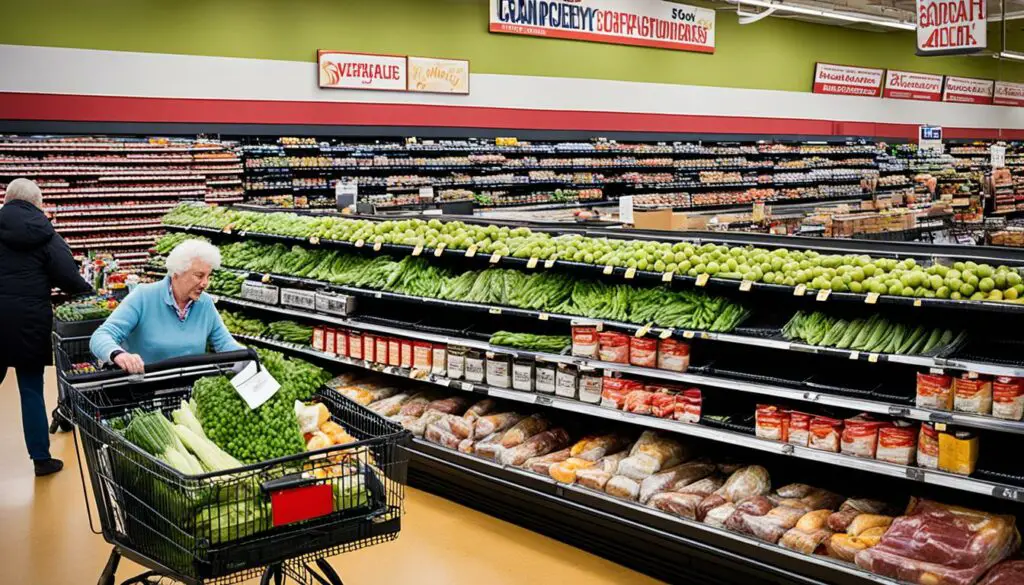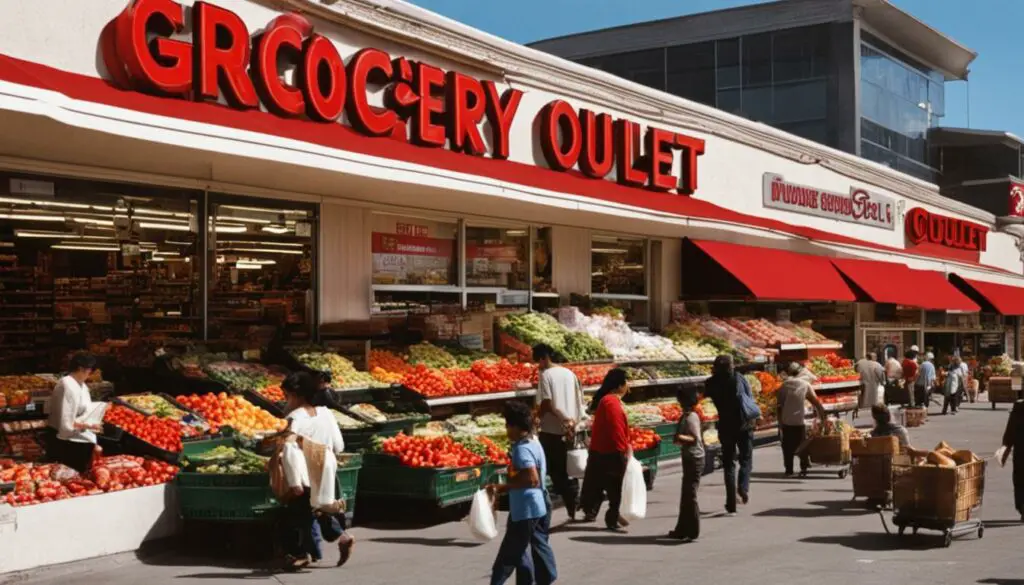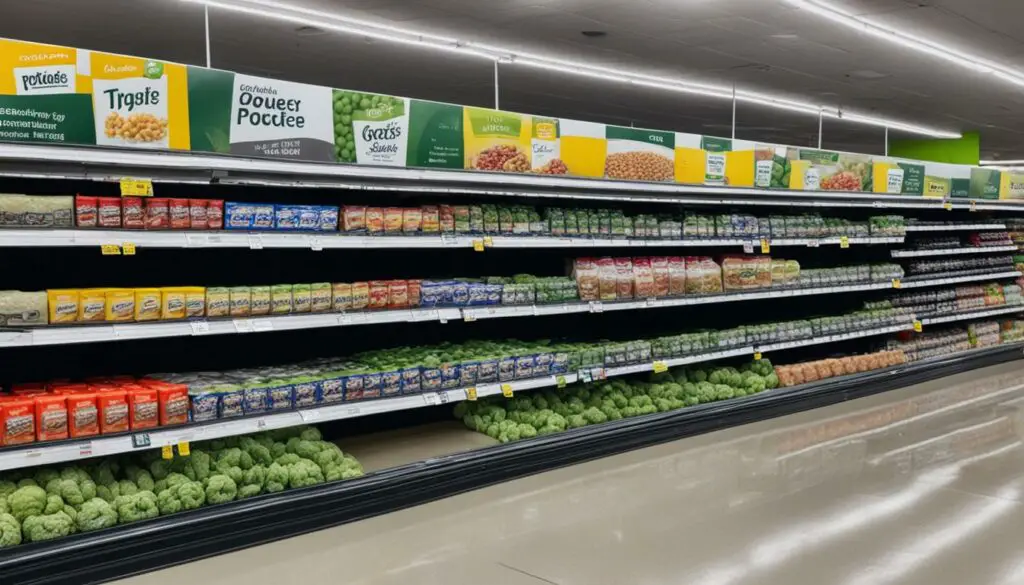Are you on a tight budget and looking for affordable grocery options in Canada? Look no further! In this article, we will uncover the cheapest grocery store in Canada, along with other budget-friendly options that will help you save money on your grocery bills.
Table of Contents
Key Takeaways:
- Discover the cheapest grocery store in Canada
- Explore other affordable grocery options
- Learn smart shopping strategies to save money
- Understand the importance of competition in the grocery industry
- Get insights into the future of grocery shopping in Canada
Canadians’ Grocery Shopping Habits

The grocery shopping habits of Canadians play a significant role in shaping the retail landscape of the country. According to a survey conducted by the Competition Bureau, several grocery store chains have emerged as the top choices for Canadians when it comes to purchasing their daily essentials. The most popular grocery stores in Canada are Loblaws, Walmart, Costco, Metro, and Sobeys.
Among these options, Loblaws and its affiliated stores hold the highest market share, with 49% of Canadians preferring this retail giant for their grocery needs. Sobeys and Metro follow closely, garnering 28% and 22% of the market share, respectively.
The survey also revealed interesting insights into the frequency of grocery shopping among Canadians. While a small percentage of individuals (3%) buy groceries daily, the majority (44%) prefer to shop once a week. Additionally, 37% of Canadians opt for two to three grocery trips per week, balancing convenience and freshness in their shopping routines.
Understanding Canadians’ grocery shopping habits is crucial for retailers to stay relevant and cater to their customers’ preferences. By providing a wide selection of products, competitive prices, and convenient locations, these grocery stores can continue to meet the needs of Canadians across the country.
The Rise of The Grocery Outlet

The Grocery Outlet, a popular grocery chain in Ontario, has been making waves in the industry with its affordable prices and unique business model. Thanks to a viral TikTok video posted by user BailsBarbosa, The Grocery Outlet has experienced an unprecedented surge in customer interest and footfall. Users were amazed by the incredibly low prices showcased in the video, prompting them to flock to The Grocery Outlet to get a taste of the savings themselves.
Co-owned by Carolyn Boiani, The Grocery Outlet prides itself on offering customers a wide range of products at significantly discounted prices. How do they manage to keep their prices so low? The secret lies in their sourcing strategy. The Grocery Outlet purchases off-spec or imperfect products directly from manufacturers, allowing them to sell these items at a fraction of the original cost. These products may have minor imperfections in appearance but are still of high quality and taste.
With an average discount of 30 to 70 percent off, The Grocery Outlet provides consumers with affordable grocery options without compromising on quality. This commitment to offering budget-friendly prices has made them a go-to destination for cost-conscious shoppers looking to stretch their grocery budget without sacrificing value.
If you’re looking for the grocery outlet, look no further than The Grocery Outlet for unbeatable affordability and a wide selection of discounted products.
The Benefits of Affordable Groceries

When it comes to grocery shopping, affordable options not only help consumers stretch their budgets but also play a vital role in reducing food waste. The Grocery Outlet, a leading grocery chain in Ontario, is a prime example of how affordable groceries can benefit both consumers and the environment.
Carolyn Boiani, co-owner of The Grocery Outlet, firmly believes in the importance of reducing food waste. She explains that their business model focuses on selling products that would otherwise go to waste, helping to conserve resources and prevent unnecessary food waste. By offering discounted prices on these items, The Grocery Outlet ensures that they are not wasted but reach consumers who can benefit from them.
“Selling products that may not meet visual criteria but are still of good quality and taste is a win-win situation. It allows us to provide affordable options for consumers, while also contributing to the reduction of food waste,” says Carolyn Boiani.
By purchasing products from manufacturers that may be off-spec or have minor imperfections, The Grocery Outlet can offer significant discounts ranging from 30% to 70% off regular retail prices. This approach not only helps consumers save money but also ensures that perfectly edible and usable products are not thrown away.
Through their commitment to affordability and sustainability, The Grocery Outlet sets an example for other grocery stores to follow. The benefits of affordable groceries extend beyond the financial savings for consumers; they also have a positive impact on the environment by reducing food waste.
Reducing food waste is crucial for several reasons:
- Environmental Impact: The production, transportation, and disposal of wasted food contribute to greenhouse gas emissions, deforestation, and water scarcity. By preventing food waste, we can reduce these environmental impacts.
- Conserves Resources: Producing food requires valuable resources such as water, land, energy, and labor. By minimizing food waste, we conserve these resources and ensure their efficient use.
- Fights Hunger: Reducing food waste means more food available for those in need. By redirecting surplus food to charities and food banks, we can help alleviate hunger in our communities.
In conclusion, affordable groceries not only provide a financial advantage for consumers but also contribute to the reduction of food waste and its associated environmental, social, and economic benefits.
Other Affordable Grocery Options in Canada

While Loblaws, Walmart, Costco, Metro, and Sobeys are popular choices for grocery shopping in Canada, there are other affordable options available as well. Independent and international grocers are growing in popularity and can often offer competitive prices. Additionally, discount grocery stores, such as NoFrills and FreshCo, provide budget-friendly options for consumers. These options allow Canadians to find the best deals on groceries and make their shopping experience more affordable.
If you’re looking to explore other affordable grocery stores in Canada, here are a few options to consider:
- Independent Grocers: Local independent grocers are known for their personalized service and often have lower overhead costs, allowing them to offer competitive prices. Supporting these smaller businesses can also contribute to the local economy.
- International Grocers: Ethnic grocery stores specializing in Asian, Middle Eastern, or African products are becoming increasingly popular across Canada. These stores offer a wide range of affordable and unique ingredients, spices, and specialty items.
- Discount Grocery Stores: NoFrills and FreshCo are two well-known discount grocery store chains in Canada. They focus on providing low-cost options without compromising on quality. These stores often have a limited selection but offer significant savings on everyday essentials.
By exploring these alternative grocery options, Canadians can find affordable prices without sacrificing quality. Whether you’re looking for locally sourced produce, international ingredients, or discounted everyday items, these stores have something for everyone.
Comparison of Affordable Grocery Options in Canada
| Grocery Store | Specialty | Price Range | Locations |
|---|---|---|---|
| NoFrills | Discount Grocery Store | Low | Locations throughout Canada |
| FreshCo | Discount Grocery Store | Low | Locations throughout Canada |
| Local Independent Grocers | Personalized Service | Varies | Depends on the store |
| International Grocers | Ethnic Products | Varies | Depends on the store |
These are just a few examples of the affordable grocery options available in Canada. The key is to explore different stores in your area and compare prices to find the best deals. The rise of these alternative options is a positive development for consumers, providing them with more choices and opportunities to save money on their grocery bills.
Strategies for Smart Grocery Shopping

To make the most of your grocery budget, it’s important to employ smart shopping strategies. By being mindful of your spending and taking advantage of various techniques, you can save money and make your grocery shopping experience more budget-friendly. Here are some tips:
- Compare prices at different stores: Before making a purchase, check the prices of the same items at multiple grocery stores in your area. This will help you find the best deals and save money.
- Take advantage of sales and promotions: Keep an eye out for weekly flyers, online deals, and special promotions. Stock up on items when they are on sale to save money in the long run.
- Use coupons: Look for coupons in newspapers, magazines, or online coupon websites. Clip the coupons for products you regularly use and bring them with you when you go grocery shopping.
- Buy in bulk: Consider purchasing non-perishable items and household essentials in bulk. Buying larger quantities can often result in lower prices per unit, saving you money in the long term.
- Plan meals in advance: Create a weekly meal plan and make a shopping list accordingly. This will help you avoid impulse buying and prevent food waste. Stick to your list while shopping to stay within your budget.
By implementing these strategies, you can become a smart grocery shopper and stretch your budget further, ensuring that you make the most of every dollar spent.
The Impact of Increased Food Prices

The rising cost of food in Canada has had a significant impact on consumers’ budgets. As outlined in the Competition Bureau’s report, increasing food prices have put pressure on Canadians, forcing them to find ways to stretch their grocery dollars. This price inflation has made it more challenging for individuals and families to afford essential items and maintain a balanced diet.
The impact of food price inflation extends beyond financial strain. Many Canadians are now seeking out affordable grocery options to mitigate the effects of rising costs. With limited disposable income, consumers are becoming more conscious of their shopping choices, opting for stores that offer lower-priced products without compromising quality.
“The rise in food prices has resulted in a greater demand for affordable grocery options,” says Sarah Thompson, a consumer advocate. “People are actively searching for stores that can provide them with budget-friendly alternatives without sacrificing the nutritional value of their meals.”
To better understand the extent of the impact, here is a breakdown of the main consequences of increased food prices in Canada:
Inflationary Pressures on Household Budgets
Rising food prices have forced consumers to allocate a larger portion of their income to meet their nutritional needs. As a result, they may have less discretionary income available for other essential expenses or savings.
Increased Risk of Food Insecurity
For individuals or families living on a tight budget, the higher cost of food can lead to food insecurity. When the cost of groceries becomes unmanageable, individuals may struggle to afford an adequate amount of nutritious food.
Impact on Healthy Eating Habits
The rise in food prices can influence individuals’ dietary choices, potentially leading to a shift towards affordable but less healthy options. Some may opt for processed or unhealthy foods, which are often more affordable compared to fresh produce or lean meats.
To address these challenges, consumers are exploring a range of strategies such as shopping at discount grocery stores, utilizing coupons, and meal planning. Additionally, initiatives like the Good Food Access Fund are working towards ensuring all Canadians have access to affordable and nutritious food options.
It is crucial for the grocery industry to respond to these changing market dynamics. The Competition Bureau’s report emphasizes the need for increased competition to promote competitive prices and product choices for Canadian consumers. By fostering a more competitive grocery industry, it is possible to alleviate the burden of rising food prices and improve affordability for all Canadians.
| Consequences | Description |
|---|---|
| Inflationary Pressures on Household Budgets | Rising food prices force consumers to allocate a larger portion of their income to food, impacting their overall financial situation. |
| Increased Risk of Food Insecurity | Higher food costs can result in individuals experiencing difficulties accessing a sufficient amount of nutritious food. |
| Impact on Healthy Eating Habits | Consumers may resort to less healthy options due to affordability, potentially compromising their overall dietary quality. |
The Importance of Competition in the Grocery Industry

Competition in the grocery industry plays a vital role in ensuring fair prices, product variety, and consumer choice. Without competition, consumers may face limited options and higher prices, ultimately impacting their shopping experience.
Encouraging new grocery businesses and supporting independent and international grocers are essential steps towards fostering healthy competition in the industry. By welcoming new players, the market becomes more diverse, allowing consumers to access a wider range of products and services.
Implementing harmonized unit pricing requirements is another crucial aspect of enhancing competition. With these requirements in place, consumers can easily compare prices between different grocery stores and make informed decisions about where to shop. Transparent pricing fosters healthy competition among retailers, motivating them to offer competitive prices and promotions to attract customers.
“Competition is the lifeblood of markets, driving innovation and efficiency while benefiting consumers,” says John Peterson, president of the Canadian Grocers Association. “Through healthy competition, the industry can evolve, adapt to consumer needs, and create better shopping experiences for Canadians.”
Competition is the lifeblood of markets, driving innovation and efficiency while benefiting consumers.
The Benefits of competition in Canada
Competition in the grocery industry offers several benefits to Canadians. Firstly, it ensures fair pricing by preventing monopolistic practices and price gouging. With multiple players vying for market share, grocery stores are motivated to offer competitive prices and promotions, ultimately benefiting consumers.
Secondly, competition stimulates product variety and innovation. Retailers strive to differentiate themselves by offering unique products or services, providing consumers with a wider range of options. This diversity ensures that consumers can find products that suit their preferences and dietary needs.
Finally, competition leads to improved consumer choice. When multiple grocers compete for customers, they are more likely to cater to diverse consumer needs, including organic, gluten-free, or locally sourced products. This broader range of choices empowers consumers to make decisions that align with their values and preferences.
Competition in the Grocery Industry
The current state of competition in the grocery industry in Canada can be visualized through the following table:
| Major Grocery Chains | Market Share |
|---|---|
| Loblaws | 30% |
| Sobeys | 15% |
| Metro | 12% |
| Independent Grocers | 18% |
| International Grocers | 10% |
| Other | 15% |
This table highlights the distribution of market share among major grocery chains, as well as the presence of independent and international grocers. While major chains dominate a significant portion of the market, independent and international grocers contribute to healthy competition and offer alternative choices for consumers.
By promoting a competitive grocery industry, Canadians can enjoy fair prices, diverse product options, and an improved shopping experience. Encouraging new entrants, supporting independent and international grocers, and implementing transparent pricing practices are essential steps in fostering healthy competition.
Responding to Consumer Needs
The grocery industry in Canada is constantly evolving, and meeting consumer needs is crucial for its growth and success. The Competition Bureau’s report emphasizes the importance of addressing barriers to competition and implementing strategies to support new players in the market. By doing so, the industry can better meet the needs of Canadian consumers and make improvements for a more competitive and budget-friendly market.
One of the key aspects of meeting consumer needs is providing affordable options. Canadian consumers are increasingly looking for grocery stores that offer affordable prices without compromising on quality. By offering competitive prices and value-for-money products, grocery retailers can attract and retain more customers.
Another important aspect is increasing product choices. Consumers have diverse needs and preferences, and providing a wide range of products can cater to these individual preferences. This includes offering a variety of brands, organic and locally sourced options, and catering to different dietary restrictions and preferences.
Fair pricing is also essential in meeting consumer needs. Canadians expect transparency and fairness when it comes to pricing in the grocery industry. Implementing pricing policies that ensure fair prices and prevent price gouging can build trust and loyalty among consumers.
By taking steps to improve the grocery industry in Canada, such as supporting new players, providing affordable options, increasing product choices, and ensuring fair prices, the industry can better meet the needs of Canadian consumers. This not only benefits consumers but also promotes healthy competition and innovation in the market.
Meeting consumer needs is not just about delivering groceries; it’s about understanding their preferences, providing value, and creating an exceptional shopping experience. By continuously striving to improve the grocery industry, we can ensure that Canadian consumers have access to affordable, diverse, and high-quality products that meet their evolving needs.
As the grocery industry in Canada continues to evolve, consumer needs will remain at the forefront. By actively responding to these needs and implementing strategies to improve the industry, grocery retailers can create a more competitive and customer-centric market that benefits both consumers and businesses.
The Future of Grocery Shopping in Canada
The grocery industry in Canada is constantly evolving, driven by new trends and innovations that transform the way Canadians shop for groceries. With an increased focus on affordability and the growing demand for budget-friendly options, the future of grocery shopping in Canada looks promising for consumers.
One major trend that we can expect to see is a greater variety of affordable grocery stores. These stores cater to budget-conscious customers by offering competitive prices and a wide range of products. In addition to traditional grocery chains, independent and international grocers are gaining popularity for their affordability and unique offerings.
Online shopping is also becoming increasingly popular in the Canadian grocery industry. Consumers are embracing the convenience of ordering groceries from the comfort of their homes and having them delivered right to their doorstep. This trend is expected to continue growing, with more grocery retailers expanding their online presence and offering innovative delivery options.
Furthermore, increased competition among major players in the grocery industry is set to benefit consumers. As competition intensifies, grocery retailers will strive to attract customers by offering lower prices, better deals, and enhanced shopping experiences. This competition will drive innovation and lead to a more customer-centric approach among grocery retailers.
To provide you with a visual representation of the current trends in the Canadian grocery industry, here is a comprehensive table showcasing the future of grocery shopping in Canada:
| Trends | Description |
|---|---|
| Increased variety of affordable grocery stores | Expansion of independent and international grocers offering competitive prices and unique products |
| Rise of online grocery shopping | Growing popularity of ordering groceries online for home delivery |
| Greater competition among major players | Supermarkets competing for customers by offering lower prices, better deals, and improved shopping experiences |
With these trends shaping the future of grocery shopping in Canada, consumers can look forward to more choices, better deals, and a more convenient shopping experience. As the industry continues to evolve, it is essential for grocery retailers to prioritize affordability and meet the changing needs of Canadian customers.
Stay tuned for the concluding section of our article, where we summarize the cheapest grocery store options in Canada and provide key takeaways for budget-conscious shoppers.
Conclusion
After exploring the options, it is clear that there are several choices for finding the cheapest grocery stores in Canada. While popular names like Loblaws, Walmart, Costco, Metro, and Sobeys are frequently chosen by consumers, there are affordable alternatives available as well. The rise of The Grocery Outlet and discount grocery stores offers budget-friendly options for those looking to save on their grocery bills.
By implementing smart shopping strategies and taking advantage of competitive prices, Canadians can make significant savings on their grocery expenses. Comparing prices, utilizing sales and promotions, using coupons, buying in bulk, and planning meals in advance are all effective ways to stretch the budget. These strategies help consumers make the most out of their grocery shopping experience and find the best deals.
Competition in the grocery industry plays a vital role in keeping prices fair and providing a wide range of products for consumers to choose from. With a focus on affordability and innovation, the future of grocery shopping in Canada looks promising. Budget-conscious shoppers can look forward to a variety of options and increased competition among major players, which ultimately benefits consumers by offering better choices and more affordable prices.
FAQ
What is the cheapest grocery store in Canada?
The cheapest grocery store in Canada can vary depending on location and individual preferences. However, some popular budget-friendly options include The Grocery Outlet, NoFrills, and FreshCo.
Are there any affordable grocery stores in Canada?
Yes, there are several affordable grocery stores in Canada. Loblaws, Walmart, Costco, Metro, and Sobeys are popular choices, but there are also independent and international grocers, as well as discount grocery stores, that offer budget-friendly options.
Where can I find low-cost grocery options in Canada?
Low-cost grocery options in Canada can be found at discount grocery stores like NoFrills and FreshCo, as well as independent and international grocers. These stores often offer competitive prices and budget-friendly deals.
What are the best deals on groceries in Canada?
The best deals on groceries in Canada can be found by comparing prices at different stores, taking advantage of sales and promotions, using coupons, buying in bulk, and planning meals in advance.
Are there any discount grocery stores in Canada?
Yes, there are discount grocery stores in Canada. Some examples include NoFrills, FreshCo, and The Grocery Outlet, which offer discounted prices on a wide range of products.
What are some affordable supermarket chains in Canada?
Affordable supermarket chains in Canada include Loblaws, Walmart, Costco, Metro, and Sobeys. These stores often offer competitive prices and a variety of budget-friendly options.
How can I budget grocery shopping in Canada?
You can budget grocery shopping in Canada by comparing prices, using coupons, buying in bulk, and planning meals in advance. By being mindful of your spending and utilizing these strategies, you can save money on your grocery bills.
Which grocery stores in Canada are known for inexpensive prices?
Some grocery stores in Canada that are known for inexpensive prices include The Grocery Outlet, NoFrills, and FreshCo. These stores often offer affordable options and discounted prices.
Source Links
- https://www.narcity.com/report-reveals-grocery-prices-canada-cheaper-where-people-shop
- https://www.cp24.com/news/ontario-grocery-chain-that-went-viral-for-low-prices-reveals-how-they-keep-costs-down-1.6266139?cache=yesclipId10406200text/html;charset=utf-80404/7.311989/7.311989
- https://toronto.ctvnews.ca/ontario-grocery-chain-that-went-viral-for-low-prices-reveals-how-they-keep-costs-down-1.6265598
See also:
Leave a Reply